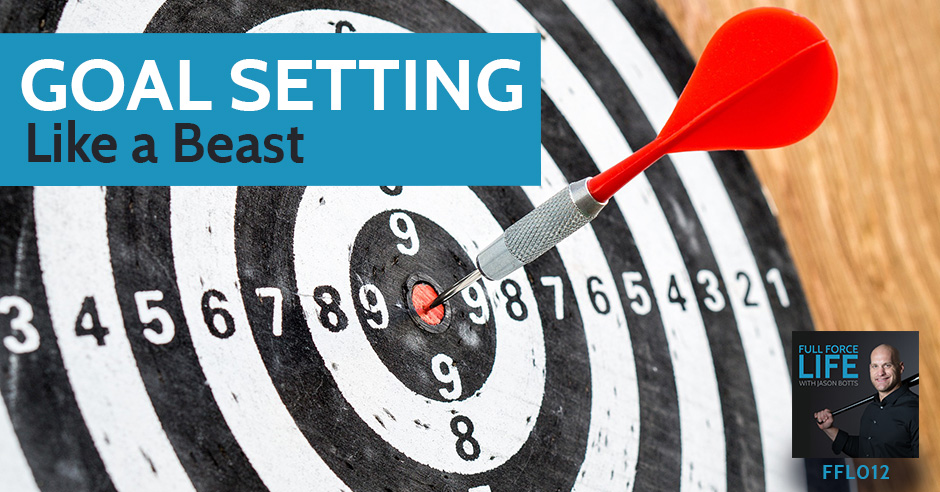
Coach Jason walks you through principle #3, DEPUTIS, a Goal Setting System that has been taught to athletes and teams of the MLB, NFL, AFL and U.S. Army Rangers. Learn what Jason considers common mistakes in setting goals that leads to frustration and overwhelm and then how to properly design them in a manner that puts your brain on a 24-hour a day mission to achieve them. By the end of this episode–you too will know how to set goals like a Beast.
Listen to the podcast here:
Goal Setting like a Beast
I call this a special edition because I wanted to make it another one of our teaching editions here, either part of the Full Force Life or these BE A BEAST principles that travel around, teaching workshops to young athletes and to businesses as well. I’m excited because I want to talk about goal-setting. The reason why this was on my heart, we have so many great achievers, people who are top, peak performers in their different positions, different sports, different coaches, and different businesses. It’s been an honor to learn from them. They all have the same theme along, where they’ve set this vision, set these goals that tied into them, and went out there and focused on the little things that they need to do to reach them.
I think back to my upbringing as a young athlete, thinking of the high school days, the college days, even as a professional baseball player. At all stages, I had all these well-meaning coaches. At the professional ranks, I was around such tremendously bright sports psychologist types, people that teach this similar stuff. I remember everything being so incomplete from what I’ve learned over the last couple of years, especially when it comes to step number three of this BE A BEAST system where we talk specifically about creating a goal-setting system.
First, what comes in mind, thinking back to those days with these coaches, they’d say, “Goals are important.” Yes they are, great drop-in. They say something about, “You need to write your goals down,” which is correct. You need to do it. You write them down. It adds more power to them. It makes them more important in your nervous system. They say something, “State them in the positive.” It’s absolutely a great advice. You got to do that. You got to give it a date. But I felt like that was all that they said. They pat you on the butt and say, “Go get them, Botts. Go set your goals. Go achieve.”

There are so many goals I set over the years that has frustrated me to such an extent that I remember for a large period of time that I didn’t want to set goals anymore. All they did was made me frustrated. I think having those types of conversations with other people, saying that goals, they make them upset because they never achieve them, they never come true. As I’ve gotten a little better at this coaching thing, I started to ask better questions. I think they made some very common mistakes, mistakes that I used to make, ones that I’ve learned to correct and handle better. We’re going to cover some of those mistakes, some of those areas that people, they create their own problems when it comes to goal-setting.
We’re going to find a way of what exactly we can be doing in order to turn our brains into this 24-hour-a-day goal-hunting predator that I like to call, because that’s what our brains are built for. Brains are built to find targets and get to that target. That’s what we’re going to do when we use this system. I almost call it a matrix because everything ties in together. You create one goal over here. It helps you get this other goal. Give it a reason, give it a purpose, all these little details, it just adds fuel to everything about you. It’s going to help you have that BEAST mentality, or that energy. You’re just breaking through walls every single day, that idea, this concept that I have of the Full Force Life, where you just feel unstoppable with everything you go through.
I think back to those high school days. I think back to those types of goals. I remember an interesting story. I remember there was this one goal, fifteen years old. To give you a little back story on it. At that time, I was a sophomore in high school, just had been called up to the varsity team, pitching, doing great. Yes, I was a pitcher once upon a time. I didn’t really amount too much pitching. Luckily, I chose hitting and playing the outfield in first base. It served me a little better in the long run fortunately. Way back then, I was pitching on the hill in Paso Robles, California. After the game, an old-timer scout, Bird Dog Scout, came up to me and he handed me this scout card. In the corner was this little picture of the Baltimore Orioles logo. It was really pretty basic stuff. I remember being so excited. I remember feeling like I’ve been found. This dream of mine, of being a Major Leaguer someday, maybe it was achievable after all. Maybe I can make it a goal. That’s what I did that night.
I remember sitting in my room, looking at this card. It was fine. Looking back on it, it’s such basic stuff. The guy probably gave out hundreds of them just that spring alone. It got my height and my weight, where my address was, just basic stuff. That meant so much to me. I’m so excited. I sat down on my desk that night. I wrote it down. I was like, “I’m going to be a Major League Baseball player someday.” I came up with the game plan. I knew that I needed to do things that nobody else was willing to do. That’s where I focused on. I knew I had to be the very best one on the team. I knew I had to be the very best sophomore in my class, in the area, all these little things. I’m writing them down and thinking about it too.
Obviously, ten years later, I achieved that dream of playing in the Major Leagues and got to play professional for fifteen years, very blessed. Over the journey, especially the next few years, I remember the early years in the Minor Leagues especially, I remember the goal-setting system, the goal-setting process that I was using really was not working. Just like that Major League goal, I made these big, lofty goals, hitting 40 home runs in a season, something ridiculous. But I thought if I aimed for 40 maybe I can get 30. I remember being a few weeks in the season and not being on pace, nowhere even near the pace of getting 40 home runs. I get frustrated. I get upset. Every day, I was thinking about this goal, hitting 40 home runs, hitting 40 home runs, hitting 40 home runs. It would just wear me down. It would beat me down.

Looking back on it now, I’m thinking, “I made this one lofty big goal, then there was other lofty goals, what was the difference? One stressed me out. One I ended up achieving years later.” That’s the first thing I like to bring up in mind when we talk about goals. There are different types of goals. There are different things we need to do with those goals; the amount of focus, the amount of energy, the amount of time that we spend thinking about it every single day. There are differences when it comes to those three types of goals.
The first goal in Extreme Focus, we like to call it the Big Kahuna. Playing in the Major League someday, when you’re fifteen years old and you set that goal, that is a Big Kahuna goal. Hitting 40 home runs in a season is a Big Kahuna type of goal. The second type of goal is what I call, Stretch Goals. Stretch Goals are the ones that are not really achievable just at the moment. We need to stretch. We need to grow. We need to expand who we are, what we’re capable of, in order to achieve this type of Stretch Goals. The third type of goal are what I call, Developmental Goals.
Maybe you’re familiar with Slight Edge, the book written by Jeff Olson. It talks about things that are easy to do and easy not to do. These are the Developmental Goals I like to call them. You set a goal, “I’m going to do this five times a week. I’m going to do this once a day.” Whatever it is, things that you know you can do them. You just need to get them done. The goal is how many times you’re going to get it done, how consistent you’re going to be. If you keep focusing on those Developmental Goals every single day, eventually you just naturally grow. You naturally expand into that Stretch Goal and achieving that Stretch Goal. Over time, you keep achieving different Stretch Goals, naturally, this Big Kahuna, it becomes a Stretch Goal as well.
The difference, looking back on my own story, I make this Big Kahuna goal of being a Major Leaguer. It never frustrated me and never got me upset. I made these Big Kahuna goals of hitting 40 home runs in a season, they made me frustrated. They get me upset. We had a guest on here not that long ago, Susan Stageman, NLP Master Trainer, 30 years of experience of working with people and helping them achieve their goals, achieve their outcomes. I asked her specifically about, how do you know when a goal is too big and what’s the difference between a Big Kahuna? I had explained to her what a Big Kahuna was, because that was my words, not hers. This is my idea of what a Stretch Goal is. “How do you know when your goals are too big?” She said, “If they get frustrated, if they weigh you down, they’re too big for you to be focused on a daily basis.” I thought about that.
When I was a young kid in high school, I set this big goal to be a Major Leaguer. I didn’t think about being a Major Leaguer. I did, of course I fantasized about being a Major Leaguer but I didn’t compare myself to being a Major Leaguer at that age. I was fifteen, I was just trying to be one of the best players on the team as a sophomore. I was thinking about, every day, how I can be the best high school baseball player I could be on that team. Those were the Stretch Goals I was thinking about every single day. I was working on those Stretch Goals. I was setting out these Developmental Goals, how many swings I was going to take every practice? How many extra swings? How many extra ground balls I was going to take? That was where all my focus was. That was where all my mental energy was going on.

When I thought about those 40 home runs, I think I even mentioned it when I was just speaking naturally. Every day, I was thinking about hitting 40 home runs. I was comparing myself to a 40 home-run-type season, which you can’t hit 40 home runs in a day anyway. Looking back, if I was a lot smarter, if I knew then what I know now, if I really wanted to hit 40 home runs in a season, I would be thinking about how many hard balls I need to hit each day or how many home runs I need to hit a week. Break it down. One and a half home runs a week probably. That’s a lot less stressful. That’s not going to be an overwhelming type of thing to do if you try to hit one home run, one and a half home runs every seven games, break it down into chunk sizes, smaller Stretch Goals.
Other great examples of these different size goals, I think about the high school team that I worked with the soft ball team. One specifically that I’ve worked now with for two years in a row, the first time I sat down with him and I explained to him this concept, I taught him the process of setting these goals, using this system. I remember walking them one by one, “What are our Big Kahuna goals?” They throw out a bunch of Big Kahuna goals. Then we go to these Stretch Goals. They keep throwing up Big Kahuna type goals. I’m like, “Whoa. We’re all freshmen and sophomores here. These goals are a little big for us right now.”
It was interesting. I go back the second year. They’ve been with these BE A BEAST principles, they had access to this goal-setting system all for the last year, talking about it, growing themselves, expanding even when I’m not there. This team’s on fire, by the way, when I get there. They’re 16-3 on the season. At the time, 3-0, 4-0 in district. Lately, now they’re 7-1, 8-1, doing big things. They get this system. They get the goal-setting. They get the idea of the BE A BEAST mental skill system. They go out there and they use it.
I go and teach the next workshop this spring. I ask them, “What’s our Big Kahuna goal?” They go, “We want to win state.” I’m like, “It’s your second year as a high school team. You want to win State. That’s a Big Kahuna goal. You guys are just annihilating teams this year, so I’ll let that slide. Big Kahuna goal: win State.” Now, I want to see where they are with their Stretch Goals because this was most important to me. Where you set your Stretch Goals is what’s most important in my opinion.
Their first Stretch Goal is to make the playoffs. “If we want to win State, we got to make the playoffs first.” I’m like, “We’re starting to get it. This is nice. What’s next?” “If we’re going to make the playoffs, then we need to win ten games in District.” “I like this. As well as you guys have played all year and the start that you’ve gotten off in District at that time, I think you can make that Stretch Goal even bigger. Let’s not just make playoffs. I think you guys have what it takes to go out there and compete and expect to win a game. Let’s go out and try to win our first playoff game when we go out there.” We added that down. I was like, “What are the Developmental Goals?” They gave out a lot of individual ones. It was great. It was like an extra hundred swings a week. They come in early, stay in late, work on extra conditioning, extra training, getting in the weight room two days a week, all these little Developmental Goals that they need to do in order to grow, expand themselves as a team so they hit those Stretch Goals.

How are we going to remember? What is the animal? What is the trigger that’s going to help us remember this idea of setting goals? It’s going to be the meerkat. Yes, the meerkat. I know it’s confusing. Why do we choose a meerkat? Is the meerkat that little squirrel-looking thing from the movie The Lion King? Yes, that is Timon, the meerkat. I don’t know if you’ve ever seen it. Maybe you’ve got younger brothers and sisters like I do. There was another Lion King. It was actually the story behind the story of Timon and the warthog, Pumba, meeting up.
In the very beginning of that movie is the scene with Timon and his family, and their whole little community of meerkats. They’re underground. They’re on top of the ground. You see all the tunnels inside where all the meerkats live. You see that they all have different jobs, different roles; some are digging the tunnels, some are security, they’re standing out there on the outside seeing if any predators or any danger are coming in. If they see something, they let out a holler. Everybody goes back in the holes. It wasn’t in the movie but I’ve read and I’ve heard that there are some meerkats that are actually, they serve as babysitters.
They actually have a job, a responsibility, where certain ones actually take care and serve as babysitters for the young. It’s a system. They’ve got this community and everything’s connected; all these tunnels and all these things that are going on. It’s just a great metaphor, especially when we talk about teams and organizations. Ultimately, when we talk about these different types of goals, you got your Stretch Goals, but you got your Developmental Goals and so much of your Developmental Goals are individual based. What is going to be your role, your responsibility? You do your job. You do your part. You help other people do their part and everything’s going to work together for the greater good. That’s why it’s such a beautiful metaphor, this idea of the meerkat and how everything’s being connected.
Also, you’ll see not only the connection between all the different goals, how the Developmental Goals serve the Stretch Goals, and the Stretch Goals end up serving the big kahuna. When you get into these next steps, you’ll see how it all ties together as well. Our way, not only to remember about goals, being the animal trigger, this visual trigger that our subconscious mind is going to help us remember is the meerkat. The meerkat’s name is going to be DEPUTIS. It’s going to be an acronym. It’s going to be an important acronym.
This is where people make a lot of mistakes, getting the chance to talk to people about their goals and helping them establish new ones and just asking what they think they should do first, this is where a lot of problems show up. When we talk about DEPUTIS, we talk about the DE it stands for describe. You need to take the time to describe what this goal is in as much detail, whatever you want. That’s an interesting thing to bring up to begin with. Usually, when you ask someone what they want, the majority of time people will tell you what they don’t want. It’s hard to hit a target when the target doesn’t exist.

You need to take the time and write down as much detail, what this target is that you’re going after? Not just what it looks like. What does it sound like? What are people going to say when you achieve it? What’s going to be going on in your own head? What are you going to be saying to yourself once you achieve it? What’s going to be the feeling in your body once you have it, once you’ve gotten there? What are you going to move like?
I always tell baseball players, especially the ones who have this dream where they make this goal of being a Major Leaguer. I’m like, “Describe it to me. What are you going to hear with the crowd? What’s going on? If you’re standing in the outfield in San Francisco, tell me what the garlic fries are going to smell like. I want that kind of detail.” The more detail that you’re able to give, the better you’re able to describe it, the more clarity and direction you’re giving your brain as that goal-hunting mechanism it is where to find it. Consciously, we’re only aware of a couple of things at any moment. Really, we can only focus on one thing well at a time. There have been so many studies done now on multitasking to prove that if you do more than one thing at a time, you’re just doing more than one thing at a time poorly.
Consciously, we can really do one thing well at a time. Your subconscious brain, your subconscious mind, can handle up to 30 tasks at one time. Even when you’re sleeping, it’s going to work for you. If you describe in tremendous detail what it is you want, all the decisions, all the actions, all the behaviors that you’re going to be doing 24 hours a day. Subconsciously, it’s going to be steering you in the direction of this goal that you set, that you’ve taken the time. That’s why the more clarity, the more description, the better you’re able to describe it, the more power you have behind it in giving your brain the direction of where to go and make the decisions you need to make. This is important.
The PU of DEPUTIS. PU stands for purpose. What does purpose do? What does having this thing going to do for us? Ultimately, the reason why we set goals isn’t to get things, isn’t to achieve things, it’s who we become in the process. It’s what it does for ourselves and what it does for others, how’s it going to make you feel? This is the ultimate reason why we’re setting this goal to begin with. What is having this or getting this or getting there going to do for you or the people you care about? The purpose behind this goal is the driving force. It is the energy. It is the motivation, the inspiration behind it all.
It’s a Stretch Goal. Most of the goals we’re setting are Stretch Goals. They’re not going to come easily. We’ve got to grow, we’ve got to expand, not only our skills and our capabilities, but our beliefs in ourselves, our belief systems. It’s not going to come easily. We’re going to get knocked down. There’s going to be bumps in the road. There’s going to be brick walls that we run up to. Ultimately, it’s the driving force, the size of the purpose, the number of reasons that we must make a way, that we have to find a way, that we’ve got to get through that brick wall, that determines if we continue to keep going or if we just give up.

Another common mistake that people make is they don’t take the time to establish enough reasons. They don’t take the time to create enough purpose and associate it into their bodies. Whenever they need it, they feel the must inside themselves to get this done. Later on, we’re actually going to create, we’re going to strengthen, we’re going to condition the reasons why and the purpose behind it all, so it’s there whenever we need it. It’s like training a muscle. Sprinters, you go out there. You don’t train to be faster so you run and walk as a fast as you can. You train yourself to be faster so at times that you need it, you’re faster. That’s the same thing that we’re going to do with our purpose and our emotions. We need to train them and condition and strengthen them, so at the times that we need it, the times that we hit up against that brick wall, we can activate that purpose inside of us that push right through the brick wall.
The next important part is the timeline, dating it. The reason why this is so important, when you get back into your brain and how your brain works, we talked about the subconscious mind and how we react so well to the detail in which we describe it. When you give it a timeline, giving it also your subconscious brain this direction and the sense of urgency. You’re giving it a priority that says, “I’ve got to figure this thing out by this time. This is what I’m looking for because I took the time to describe it.” The purpose, you establish enough purpose. You’re giving it a high enough priority in your brain. The more purpose you give it, the higher priority it has. Then you add that timeline that gives the brain a sense of urgency. “I’ve got to find a way by this time.”
Those are the three really important steps. Now, step number four, the S” to it all, a strategy. That’s important too. Usually, what happens when people set goals, what do they do? They come up with this vague idea of what is it they want and they go right to the S right to the strategy. They come up with this game plan. They figure out, “I don’t really know a game plan. I don’t know how I’m ever going to achieve this. I don’t know how I can get it done.” What do they do? They never really actually set the goal. They definitely never take any steps towards achieving it.
If you’d really get into the description, describing it, you create that purpose, all these reasons why you’ve got to find a way to get this done. You give it that sense of urgency by creating a timeline. You don’t need a strategy when you start off. Your brain, as it goes along, will be working for you 24 hours a day. It will let you know what strategies existed. They were there all this time, but you never saw them because they just weren’t important to you at that moment. Your brain is activating and saying, “This is important.” 24 hours a day, it’s looking for a way to achieve this goal. Also the strategy starts popping up.
That’s DEPUTIS, the meerkat. Once again, DEPUTIS is describe, purpose, timeline, strategy. We covered the problems and we cover the antidote, the solutions to it all. Now, I hinted before talking about conditioning, about training yourself to achieve these goals and to condition yourself to resourcefulness, to never give up, to bust through any wall. The ways that we do it, there are several different ways. We can write them down on a daily basis that we’ve already achieved them. “I’ve already made a million dollars,” whatever it is, whatever your goal is, write them down that you’ve already achieved it. Say them out loud. You say affirmations into life. One of my favorite ones is visualization. Something I started as an athlete that I’m finding it’s just as invaluable at any area of your life in achieving these types of goals.

What these three things do is it associates that purpose and that clarity and just gets into your body and your nervous system. These goals become a part of you, especially that sense of purpose. It gets activated whenever you think about it. It grows, gets stronger and stronger. The more you visualize it, the clearer it becomes to you, the more description you’re able to give to it. The more description, the more you feel, all the reasons why you feel that purpose inside in you. It becomes more of your body and you train a new strength in that. Every time you hit that bump in the road, you have it at your command. That will to keep going, to keep moving forward, to break through those walls, break through those barriers. That’s why conditioning it, visualization, writing it down is so important. You’re training, you’re strengthening it, that clarity, that description and that purpose, all those reasons behind it.
I think back to one of the other guests we had on the show, a football player. I don’t think it’s ever too young to set this process. High school’s not too young. He talked about his days in high school. He is definitely an overachiever when it comes to football. One of the reasons why he’s able to do that is because he is a goal-setting machine. When you hear his strategies for how he set goals all the way back in high school, he would sit there and he would write them down and he’d put them right next to his door so he had to see them on the way out every time he left his bedroom. As a high school athlete, he would have to sit there and see his goals. What he did, he stopped for a minute. Just for a minute, he’d read them out loud that he already had them. All the records that he was going to break on the football field, the Vision One program that he was going to go. He achieved them all. I think he told a story that on the final play of his high school career, he called an audible. It was going to be running but he called an audible to make it a passing play and threw it for a touchdown to set his high school football record.
Give it clarity. Give it enough reasons why and your brain will find the strategies. It will find the way to get there. Your assignment, I want you right now to write down one big kahuna goal. What’s that big kahuna, big dream? Who knows if we really get there, but it would be awesome if we can. More importantly, the three Stretch Goals. What are three Stretch Goals? If you really bear down and you really grow your skills, your capabilities and your belief systems that you’re capable of this and that this is who you are as a person, you can get there. Write down those three Stretch Goals.
Then lastly, the five Developmental Goals. What are the goals that you could do either on a daily basis or a weekly basis? If you do these things that are easy to do and also easy not to do, we do them on a consistent basis, you’re going to grow into these Stretch Goals. Take the time. Write down these nine different goals. After you’ve written down these nine different types of goals, and three of them are Stretch Goals, I want you to pick one of the Stretch Goals and I’m going to walk you through a visualization, a way to condition and then train the description and the purpose behind it all. You can do this on a daily basis. Maybe this visualization can be one of your five Developmental Goals going on into the future. Maybe you can do it on a daily basis, or maybe you can do it three or four times a week, whatever you decide for yourself as your Developmental Goals, whatever fits in your life the best, whatever you’re the hungriest most to do.
Before we begin this visualization, I want you to pick that Stretch Goal, and set an intention. “This is the goal. I’m capable. I must do this.” I want you to think of something that makes you feel absolutely grateful. Gratitude, what an amazing emotion. When we get grateful, there is no fear. When you’re truly grateful, there’s no worry, no stress, no doubt, no anger. When we take the time to really associate gratitude in our body, we’re feeding that. There’s only bringing that more into our life, more things to be grateful for. I want you to associate in your body now. Feel the feelings of gratitude for someone or something. We’re going to begin attaching this feeling to our goal, being grateful for this goal already achieved.
Just go ahead and close your eyes and see your gate. You’re the designer of the gate. The gate can look any way you want it too. Once you have your gate, walk through this gate and come into this beautiful place of nature. It’s amazing. It’s beautiful. Just take a look around. Enjoy it, appreciate it. Nature loves to be appreciated. Feel the ground beneath your feet. There’s wind there. Feel it on your face, your arms. Hear the sounds that are going on this place. Just see all the beauty that’s here. Just know this is your special place and you can come to it whenever you want and feel peaceful, feel relaxed. You just take a big deep breath in. On the exhale, just blow away any fear, any worry, any doubt, any negativity. Blow away everything that does not serve you in this moment or towards achieving this goal that you set out.
As you’ve done that, I want you to see a second gate. Walk through the second gate and walk into this place of life, a time that this goal is done. This is goal is part of you, a part of who you are or where you wanted to be. Just feel in your body right now how amazing, how much pride is in you for achieving this dream. See what you’re going to see then and see it now. Hear the things that are you going to hear then and hear it now. What are the things you’re going to be telling yourself in your own head? What are other people going to be congratulating you or telling you about? Go ahead and hear them now. Just feel that amazing sensation when you know you went out there and you achieved exactly what you wanted to do to. Just feel the awesomeness that is swelling up inside of you right now. Just walk around. Feel the ground beneath your feet. Look around to see that this goal was hit. It was done. It was achieved.

Think for a second the reasons why. Why was this so important to you? Why is it so amazing now that we’re here? Is it just for you? Is it for other people? What are the real reasons that this was so important? Why was this an absolute must that you get here? Just feel blessed. Feel blessed that you achieved it, that it all came true. Feel it one last time inside your body and just carry it with you and walk out that last gate.
Come back into your beautiful place in nature again and see out in the distance a well of water. Walk up to this well and inside this well is the clearest, coolest, crispest water you’ve ever seen. Go ahead and fill it up with a cup. Drink it in. Feel it go into your mouth, down your throat, down your arms and legs, every vein, every cell of your body just replenishing you, re-energizing you, giving you the strength you need. You could have the strength whenever you need it because this place exists solely in your mind. Now, with the power of achieving inside of you, that sense of pride, that sense of energy, feeling unstoppable, walking in your own strengths, standing tall, go ahead and walk out that first gate and you can open your eyes whenever you’re ready, because you’re a goal-hitting machine, BEAST-style.
That’s how we condition it; the clarity and the purpose, the reasons why. DEPUTIS, the meerkat, part of the BE A BEAST system. As always, any questions, feel free to reach out to me, JasonBottsPeakState.com, as well as you can find me on Facebook, @JasonBottsPeakState. I love to hear your stories. I’d love to hear your goals, learn more about you. Hopefully, we’ll see each other face-to-face on one of these BE A BEAST workshops. I’ll get to share more of the other fourteen animals that we teach there. Until then, aim high. Swing hard. Smile often and live full force.
